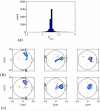A simple nonparametric statistical thresholding for MEG spatial-filter source reconstruction images
- PMID: 15990337
- PMCID: PMC4041988
- DOI: 10.1016/j.neuroimage.2005.04.009
A simple nonparametric statistical thresholding for MEG spatial-filter source reconstruction images
Abstract
This paper proposes a simple statistical method for extracting target source activities from spatio-temporal source activities reconstructed from MEG measurements. The method requires measurements in a control condition, which contains only non-target source activities. The method derives, at each pixel location, an empirical probability distribution of the non-target source activity using the time course reconstruction obtained from the control period. The statistical threshold that can extract the target source activities is derived from the empirical distributions obtained from all pixel locations. Here, the multiple comparison problem is addressed with a two-step procedure involving standardizing these empirical distributions and deriving an empirical distribution of the maximum pseudo T value at each pixel location. The results of applying the proposed method to auditory-evoked measurements are presented to demonstrate the method's effectiveness.
Figures









References
-
- Ḧam̈al̈ainen M, Hari R, IImoniemi RJ, Knuutila J, Lounasmaa OV. Magnetoencephalography-theory, instrumentation, and applications to noninvasive studies of the working human brain. Rev. Mod. Phys. 1993;65:413–497.
-
- Friston KJ, Holmes AP, Worsley KJ, Polin J-P, Frith CD, Frackowiak RSJ. Statistical parametric maps in functional imaging: A general linear approach. Human Brain Mapping. 1995;2:189–210.
-
- Worsley KJ, Marrett S, Neelin P, Vandal AC, Friston KJ, Evans AC. A unified statistical approach for determining significant signals in images of cerebral activation. Human Brain Mapping. 1996;4:58–73. - PubMed
-
- Sekihara K, Nagarajan SS. Neuromagnetic source reconstruction and inverse modeling. In: He B, editor. Modeling and Imaging of Bioelectric Activity - Principles and Applications. Kluwer Academic/Plenum Publishers; 2004. pp. 213–250.
Publication types
MeSH terms
Grants and funding
LinkOut - more resources
Full Text Sources

